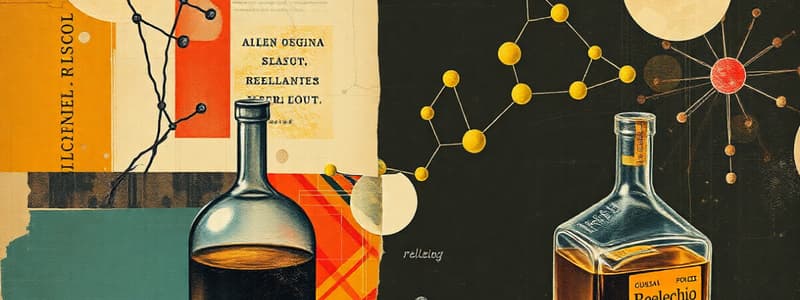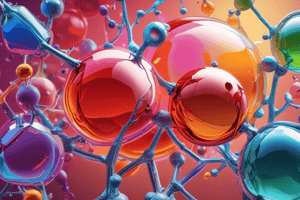Podcast
Questions and Answers
What is the functional group found in alcohols?
What is the functional group found in alcohols?
- Carboxyl group
- Hydroxyl group (correct)
- Carbonyl group
- Amino group
What is the difference between a primary, secondary, and tertiary alcohol?
What is the difference between a primary, secondary, and tertiary alcohol?
- The number of carbon atoms directly bonded to the carbon atom bearing the hydroxyl group. (correct)
- The type of functional group present.
- The acidity of the alcohol.
- The solubility of the alcohol in water.
Phenols are more acidic than alcohols.
Phenols are more acidic than alcohols.
True (A)
What happens to the solubility of alcohols in water as the size of the alcohol molecule increases?
What happens to the solubility of alcohols in water as the size of the alcohol molecule increases?
What is the principle behind the Ritter Test?
What is the principle behind the Ritter Test?
In the Ritter Test, ______ alcohols cannot be oxidized because they lack a hydrogen atom on the carbon bonded to the hydroxyl group.
In the Ritter Test, ______ alcohols cannot be oxidized because they lack a hydrogen atom on the carbon bonded to the hydroxyl group.
The Ritter Test can differentiate between primary and secondary alcohols but not between primary and tertiary alcohols.
The Ritter Test can differentiate between primary and secondary alcohols but not between primary and tertiary alcohols.
What happens to the color of potassium permanganate when it oxidizes primary or secondary alcohols?
What happens to the color of potassium permanganate when it oxidizes primary or secondary alcohols?
What is the purpose of using acetic acid in the Ritter Test?
What is the purpose of using acetic acid in the Ritter Test?
Flashcards
Hydroxy group
Hydroxy group
The functional group that defines alcohols, consisting of a hydroxyl group (-OH) bonded to a carbon atom.
Primary alcohol
Primary alcohol
An alcohol where the carbon bearing the hydroxyl group is attached to one other carbon atom.
Secondary alcohol
Secondary alcohol
An alcohol where the carbon bearing the hydroxyl group is attached to two other carbon atoms.
Tertiary alcohol
Tertiary alcohol
Signup and view all the flashcards
Phenol
Phenol
Signup and view all the flashcards
Water solubility
Water solubility
Signup and view all the flashcards
Hydrophobic
Hydrophobic
Signup and view all the flashcards
Deprotonation
Deprotonation
Signup and view all the flashcards
Ritter Test
Ritter Test
Signup and view all the flashcards
Potassium permanganate (KMnO4)
Potassium permanganate (KMnO4)
Signup and view all the flashcards
Aldehyde
Aldehyde
Signup and view all the flashcards
Ketone
Ketone
Signup and view all the flashcards
Carboxylic acid
Carboxylic acid
Signup and view all the flashcards
Oxidation
Oxidation
Signup and view all the flashcards
Cation
Cation
Signup and view all the flashcards
Anion
Anion
Signup and view all the flashcards
Color change
Color change
Signup and view all the flashcards
Acetic acid
Acetic acid
Signup and view all the flashcards
Study Notes
Alcohols and Phenols
- Alcohols are compounds containing a hydroxyl (OH) group bonded to a carbon atom.
- Alcohols are classified as primary, secondary, or tertiary based on the number of carbon atoms bonded to the carbon atom with the hydroxyl group.
- Primary alcohols have one carbon atom bonded to the carbon with the hydroxyl group.
- Secondary alcohols have two carbon atoms bonded to the carbon with the hydroxyl group.
- Tertiary alcohols have three carbon atoms bonded to the carbon with the hydroxyl group.
- Phenols have a hydroxyl group directly bonded to an aromatic ring.
- Phenols are more acidic than alcohols.
- Sufficient aqueous sodium hydroxide will deprotonate the hydroxyl group (-OH) in phenols, but not in alcohols.
Physical Properties
-
Solubility in water: Smaller alcohols are water-soluble due to hydrogen bonding. Larger alcohols are less soluble because the nonpolar alkyl groups disrupt hydrogen bonding. Phenol solubility is similar to alcohols.
-
State: Alcohols can be solid if the size of the molecule is large, and most phenols are solid.
Chemical Properties
- Oxidation: Primary and secondary alcohols can be oxidized by potassium permanganate (KMnO4) to aldehydes and ketones respectively (then onward to carboxylic acids with primary alcohols). Tertiary alcohols do not react.
- Ritter test:
- Differentiates primary and secondary alcohols from tertiary.
- Potassium permanganate (purple) oxidizes primary and secondary alcohols to form brown MnO2.
- Tertiary alcohols do not react; permanganate color remains purple.
Studying That Suits You
Use AI to generate personalized quizzes and flashcards to suit your learning preferences.




